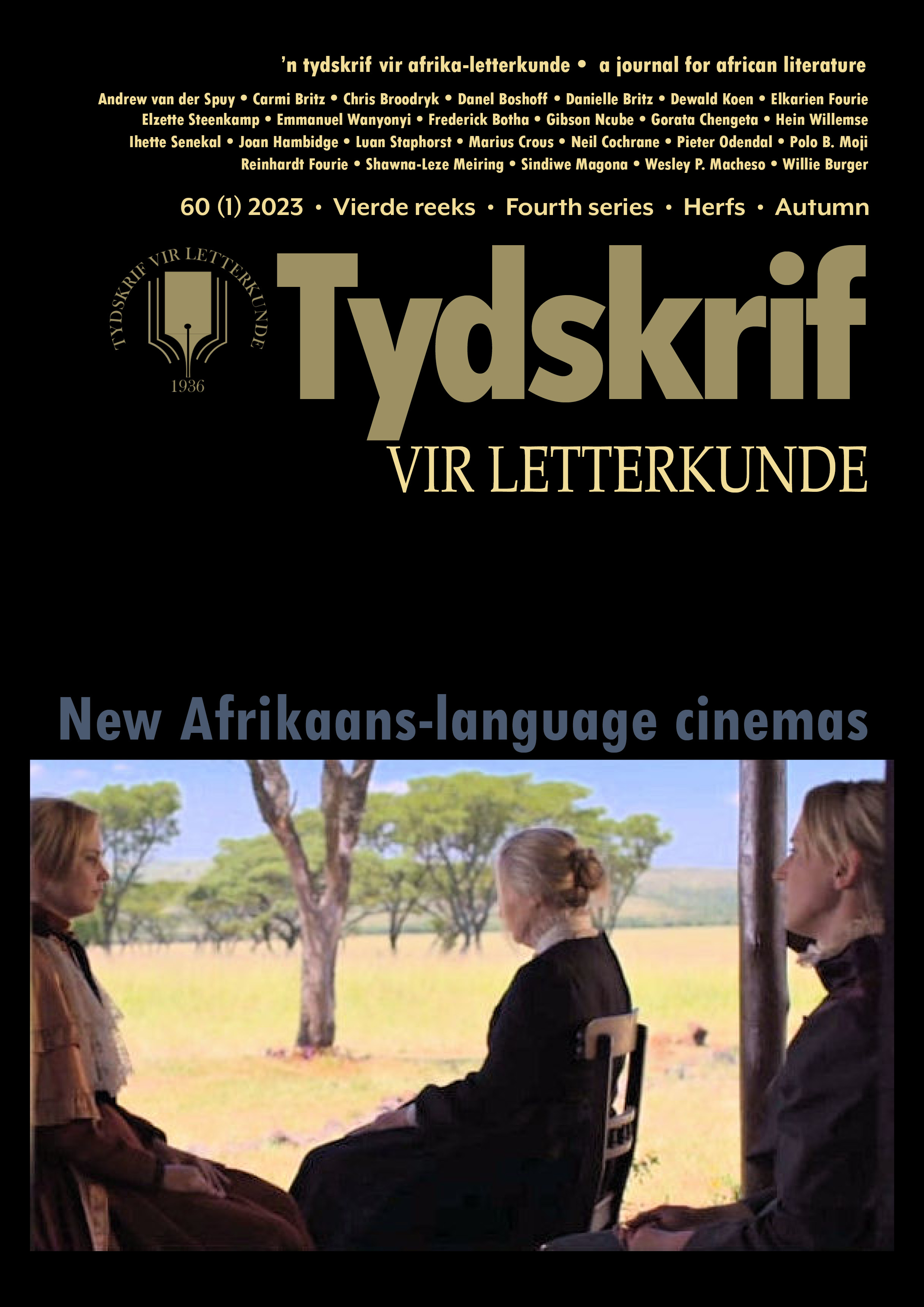Queer, chrétien et afrikaans : l’aspect libidinal, la sexualité et la religion dans Kanarie et Skeef
DOI :
https://doi.org/10.17159/tl.v60i1.14054Mots-clés :
Film afrikaans, queer, libidinal, religion, Kanarie, SkeefRésumé
La religion est souvent considérée comme incompatible avec les sexualités et les genres queer. Dans les communautés de langue afrikaans d’Afrique du Sud, la doctrine et le dogme calvinistes ont été utilisés pour marginaliser et ostraciser les identités sexuelles et de genre qui s’écartent des scénarios hétéronormatifs sanctionnés par les pratiques culturelles et religieuses. Dans cet article, j’examine comment l’élément libidinal est au cœur de la manière dont les communautés queer et religieuses interagissent dans les communautés de langue afrikaans dans deux films : Kanarie et Skeef. Ces deux films représentent des genres cinématographiques différents, Kanarie étant un long métrage de fiction et Skeef un documentaire. Les deux films, malgré leurs genres différents, abordent la difficulté d’être queer et religieux. En même temps, ils montrent qu’il est possible de repenser les religions et les communautés religieuses. Cette remise en question crée des espaces d’accueil au sein des communautés religieuses, de sorte que l’homosexualité n’est pas considérée comme une déviance ou une abomination. J’analyse ces films en langue afrikaans en tenant compte de la conceptualisation de l’élément libidinal proposée par Keguro Macharia et des idées d’influence queer proposées par Adriaan van Klinken. Cette influence queer ne marque pas seulement une transgression des normes chrétiennes hétéronormatives, mais engendre également des manières expansives de comprendre la sexualité humaine et les identités de genre.
Téléchargements
Références
Adhikari, Mohamed. “Not Black Enough: Changing Expressions of Coloured Identity in Post-Apartheid South Africa.” South African Historical Journal vol. 51, no. 1, 2004, pp. 167–78. DOI: https://doi.org/10.1080/02582470409464835.
Allen, David J. & Terry Oleson. “Shame and Internalised Homophobia in Gay Men.” Journal of Homosexuality vol. 37, no. 3, 1999, pp. 3–43. DOI: https://doi.org/10.1300/J082v37n03_03.
Andrews, Grant. “The Construction of Split Whiteness in the Queer Films Kanarie (2018) and Moffie (2019).” Tydskrif vir Letterkunde vol. 59, no. 1, 2022, pp. 52–61. DOI: https://doi.org/10.17159/tl.v59i1.12163.
Baines, Gary. South Africa’s Border War: Contested Narratives and Conflicting Memories. Bloomsbury, 2014.
Broodryk, Chris W. Absences, Exclusivities and Utopias: Afrikaans Film as a Cinema of Political Impotence, 1994–2014. Diss. U Cape Town, 2015.
Carolin, Andy. Post-Apartheid Same-Sex Sexualities: Restless Identities in Literary and Visual Culture. Routledge, 2020.
Crous, Marius. “En ek sê dis 'n trassie: Perspectives on Afrikaner Homosexual Identity.” Agenda vol. 20, no. 67, 2006, pp. 48–56. https://www.tandfonline.com/doi/abs/10.1080/10130950.2006.9674697.
Du Pisani, Kobus. “Puritanism Transformed: Afrikaner Masculinities in the Apartheid and Post-Apartheid Period.” Changing Men in Southern Africa, edited by Robert Morrell. Zed, 2001, pp. 157–75.
Durrheim, Kevin. “Socio-spatial Practice and Racial Representations in a Changing South Africa.” South African Journal of Psychology vol. 35, no. 3, 2005, pp. 444–59. DOI: https://doi.org/10.1177/008124630503500304.
Elder, Glen. “Of Moffies, Kaffirs and Perverts: Male Homosexuality and the Discourse of Moral Order in the Apartheid State.” Mapping Desire: Geographies of Sexualities, edited by David Bell & Gill Valentine. Routledge, 2004, pp. 50–8.
Falkof, Nicky. “Sex and the Devil: Homosexuality, Satanism, and Moral Panic in Late Apartheid South Africa.” Men and Masculinities vol. 22, no. 2, 2019, pp. 273–93. DOI: https://doi.org/10.1177/1097184X18774097.
Jansen van Vuuren, Anna-Marie. “(Re)constructing the Heroic Narrative in Four South African Anglo-Boer War Films.” Stilet vol. 33, no. 1, 2021, pp. 31–51. https://hdl.handle.net/10520/ejc-stilet-v33-n1-a4.
Jones, Tiffany F. “Averting White Male (Ab)normality: Psychiatric Representations and Treatment of ‘Homosexuality’ in 1960s South Africa.” Journal of Southern African Studies vol. 34, no. 2, 2008, pp. 397–410. DOI: https://doi.org/10.1080/03057070802038058.
Macharia, Keguro. Frottage: Frictions of Intimacy across the Black Diaspora. New York U P, 2019.
Ncube, Gibson. “Gender and Naming Practices, and the Creation of a Taxonomy of Masculinities in the South African Soap Opera The Queen.” Nomina Africana: Journal of African Onomastics vol. 33, no. 1, 2019, pp. 1–8. DOI: https://doi.org/10.2989/NA.2019.33.1.1.1331.
Ncube, Gibson. “Queer Afrikaner Masculinities in Oliver Hermanus’ Skoonheid (2011) and Christiaan Olwagen’s Kanarie (2018).” Stilet vol. 33, no. 1, 2021, pp. 94–9. https://hdl.handle.net/10520/ejc-stilet-v33-n1-a7.
Ncube, Gibson. Queer Bodies in African Films. NISC, 2022.
O’Brien, Jodi. “Wrestling the Angel of Contradiction: Queer Christian Identities.” Culture and Religion vol. 5, no. 2, 2004, pp. 179–202. DOI: https://doi.org/10.1080/143830042000225420.
Pieterse, Annel. “Film Notes: Masculinity, Violence, and Queer Identity in Recent South African Films.” Safundi vol. 20, no. 3, 2019, 375–81. DOI: https://doi.org/10.1080/17533171.2019.1601443.
Retief, Glenn. “Keeping Sodom Out of the Lager: State Repression of Homosexuality in Apartheid South Africa.” Defiant Desire: Gay and Lesbian Lives in South Africa, edited by Mark Gevisser & Edwin Cameron. Ravan, 1994, pp. 99–114.
Sonnekus, Theo. “We’re not faggots!: Masculinity, Homosexuality and the Representation of Afrikaner Men Who have Sex with Men in the Film Skoonheid and Online.” South African Review of Sociology vol. 44, no. 1, 2013, pp. 22–39. DOI: https://doi.org/10.1080/21528586.2013.784446.
Tomso, Gregory. “The Queer History of Leprosy and Same-Sex Love.” American Literary History vol. 14, no. 4, 2002, pp. 747–75. https://www.jstor.org/stable/3568023.
Van Der Wal, Ernst. 2019. “Masculinities at War: The South African Border War and the Textual Representation of the ‘Moffie’.” Journal of Literary Studies vol. 35, no. 2, 2019, pp. 62–84. DOI: https://doi.org/10.2519/1753-5387/11595.
Van Klinken, Adriaan. “Queer Love in a ‘Christian Nation’: Zambian Gay Men Negotiating Sexual and Religious Identities.” Journal of the American Academy of Religion vol. 83, no. 4, 2015, pp. 947–64. https://www.jstor.org/stable/43900145.
Van Klinken, Adriaan. Kenyan, Christian, Queer: Religion, LGBT Activism, and Arts of Resistance in Africa. Pennsylvania State U P, 2019.
Van Klinken, Adriaan. “Towards Humane Scholarship: Postsecular, Queer Theological, and Self-Reflexive Turns.” HAU: Journal of Ethnographic Theory vol. 10, no. 2, 2020, 637–45. DOI: https://doi.org/10.1086/709583.
Van Klinken, A. & Martin Zebracki. “Porn in Church: Moral Geographies of Homosexuality in Uganda.” Porn Studies vol. 3, no. 1, 2020, pp. 89–92. DOI: https://doi.org/10.1080/23268743.2015.1083882.
Téléchargements
Publiée
Numéro
Rubrique
Licence
(c) Copyright Tydskrif vir Letterkunde 2023

Ce travail est disponible sous licence Creative Commons Attribution - Partage dans les Mêmes Conditions 4.0 International.


 https://orcid.org/0000-0001-6465-6584
https://orcid.org/0000-0001-6465-6584


.png)